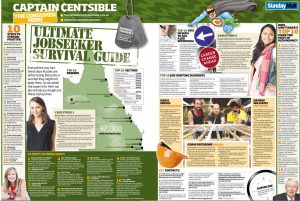The Redundancy Principle
The above image was taken from a webpage that is part of an Australian newsletter called SundayMail, http://media01.couriermail.com.au/multimedia/2012/captain-centsible-jobseeker.jpg. This section of the SundayMail is a consumer advocacy segment called Captain Centsible. This particular Captain Centsible article is related to advice for those seeking a job. Let’s take a look at the above image and analyze the efficiency in getting its message across. Although the page is well designed and laid out, the use of Top 10 lists is too redundant and overwhelming.
The article does a good job of using all three of the elements of the rhetorical appeals, ethos, logos, and pathos. Ethos is utilized by making the article seem credible. Because it is a consumer advocacy article, and it pictures a super hero caricature called Captain Centsible, it gives a sense of looking out for the welfare of the consumer. The use of ‘Cent’ in his name, and labeling him ‘The Consumer Hero’, makes him (and his advice) seem trust worthy. Logos is demonstrated by the overflowing amount of advice in the article which is evidence of knowledge of the subject. Pathos is evident in how the article appeals to a large of group of the population who are looking for a job and may feel that they could use some advice on the subject.
The article is well laid out, although it is a little visually ‘cluttered’. The elements are well balanced and have good alignment, with the left and right sides being anchored by identically formatted areas. The visual elements, such as the hard hat and the signs are related to the subject matter and give the article visual contrast. The contrast of colors gives it depth and visual appeal. The use of pictures of people, incorporating equal numbers of men and women, give it consistency. I can’t help but notice that all of the people are Caucasian and that there are no minorities represented.
The article is very redundant in its use of ‘Top 10’ lists. In all, there are 8 lists included. This article definitely uses redundancy to make its point. I feel the author has forgotten that according to Cognitive Theory, channels of information are limited, and redundant text overloads the visual channel. Working memory is limited and in order to reduce overload, only essential information should be presented.
Although the author has good intentions in trying to provide as much information as possible, it is presented in a way that is overwhelming visually and cognitively. There are so many Top 10 lists, that the reader gets tired and overwhelmed trying to take it all in. The author could have narrowed the lists down to the Top 5, or included fewer lists.

